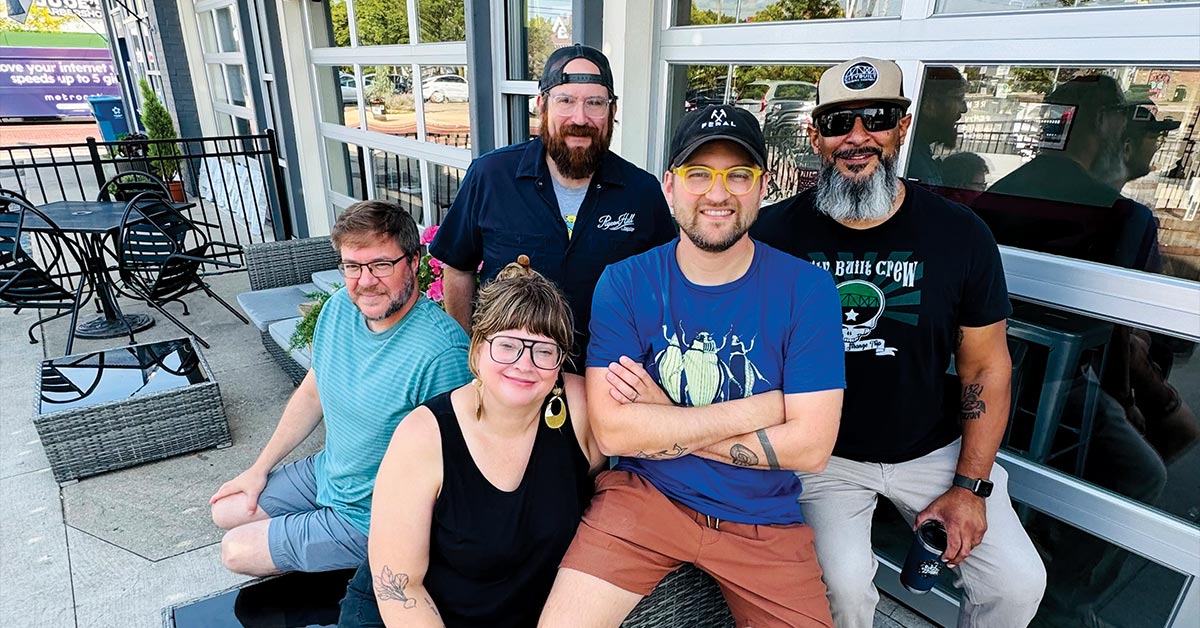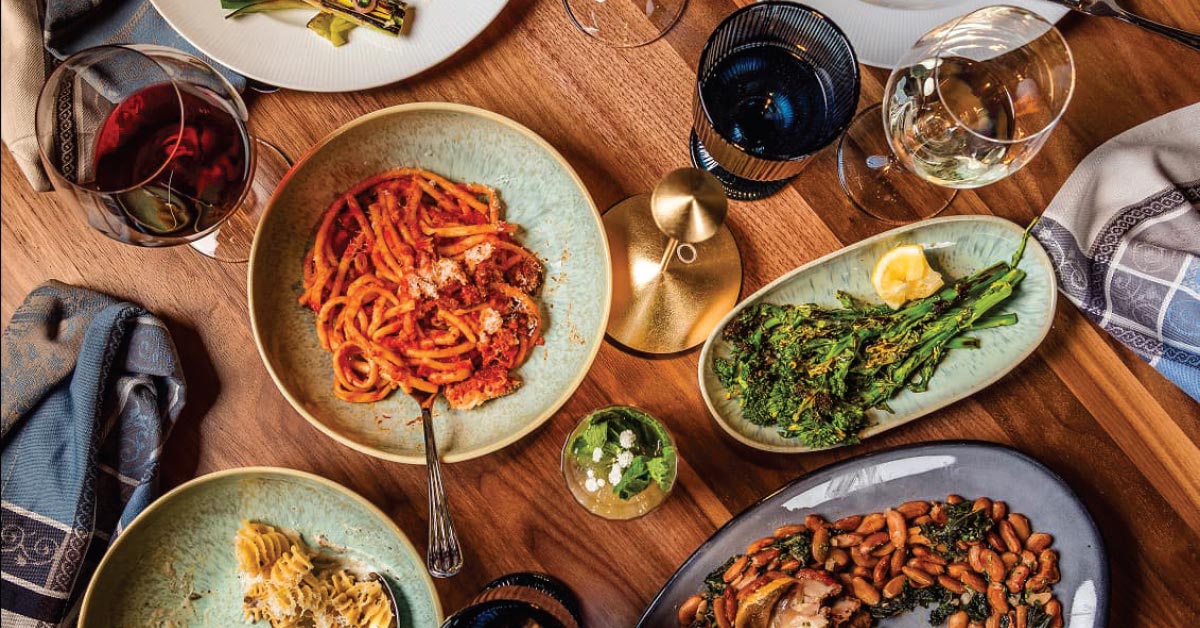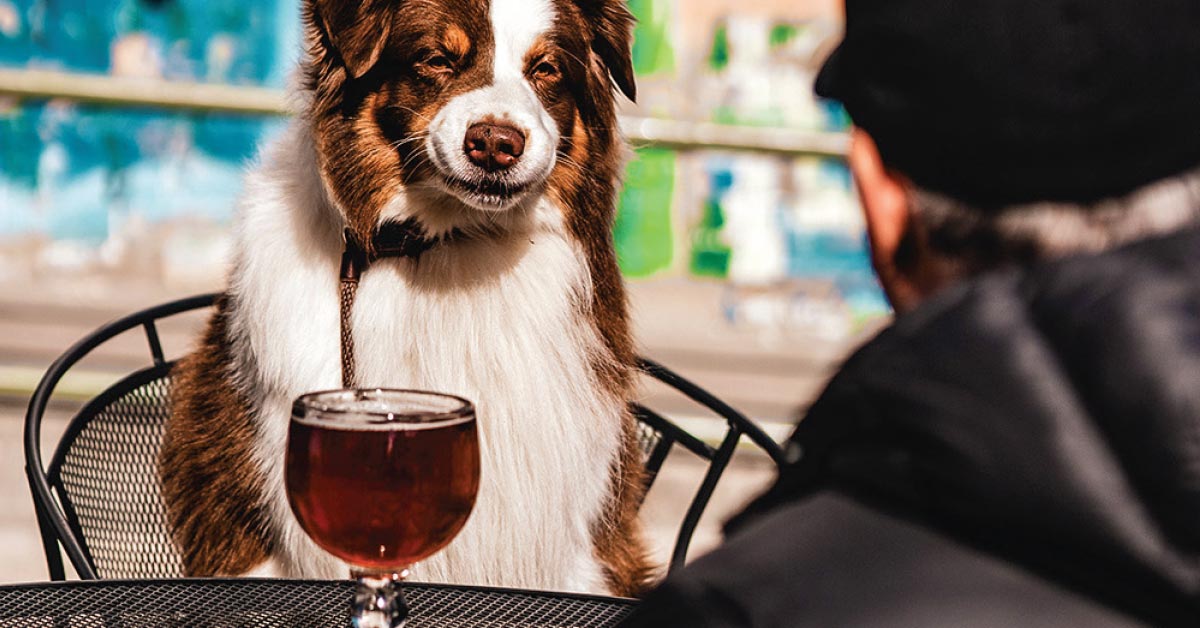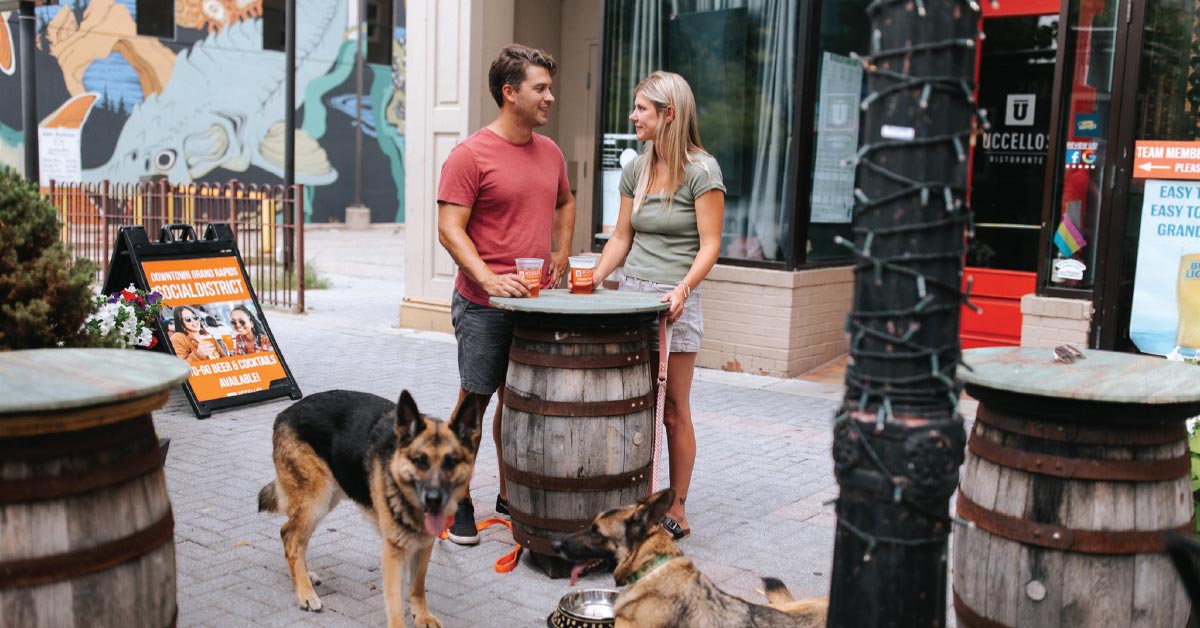Times have changed, and here in self-proclaimed Beer City, nowhere is this more evident than craft beer.
It’s not that the industry has collapsed and beer is dead, but breweries have become much more than simply a place to grab a pint of IPA. The ones that last have largely become community centers, offering a place to come and eat food, hear music, participate in events, even enjoy some pickleball or bowling.
To discuss these changing times, we invited just a few people who’ve been in the local beer industry for years and have seen the shifting trends firsthand to a small roundtable.
Hosted graciously at Harmony Brewing, we had a long chat (that could have gone much longer) about the challenges everyone in craft beer is facing and what’s coming next. Here’s just a portion of that conversation, for your reading pleasure.
PARTICIPANTS
Mitch Ermatinger, Owner at Speciation Artisan Ales
Jon Ward, Experience Warden at Brewery Vivant/Broadleaf (and more)
Heather VanDyke-Titus, Owner at Harmony Brewing
Ryan “Ryno” Wasson, Head Cellar Operator at Pigeon Hill Brewing
Ed Collazo, Owner at City Built Brewing
How have things in craft beer changed since 5 years ago?
Ward: From 2019 to now, obviously, it’s a whole new world, and not in the way that we thought it was going to be. More because of half a generation of people turning 21 that don’t know what to do. It’s kind of like the record skipped.
Collazo: Yeah, my son’s 21. He does not drink beer. He’s more of a weed guy.
Ward: That’s the story that we hear time and time again. And that’s a very good point, about how cannabis has affected the industry more from a labor standpoint, it’s very, very hard. A lot of the staff that used to be our service help, people who would come in and work their way up, are just going, “I’d rather trim bud.”
Ermatinger: Yeah, lots of employees that have left and are leaving to go work in that industry.
VanDyke-Titus: Right after Covid, it was just a completely different industry.
Ermatinger: A big part of the appeal of craft beer was the communal element of it. You take that away and you can’t just be, like, “It’s back now.”
Ward: People learned how to have fun without it. And now they don’t want us to just provide the bigger the platform to have fun, they want us to also provide the fun. That’s been the biggest change for us. We have to not just be a brewery and restaurant, now we have to be an event place, to generate what you’re going to do, instead of just like, “Come here, drink a few and maybe hook up?”
What types of events are working for you?
Ward: They come in waves. It’s like, everyone’s excited about trivia, and then everyone’s excited about vinyl night, and then everybody’s excited about dogs.
Ermatinger: It depends on which ones really pick up steam and which ones you have partners that really push it. But yeah, every brewery is now doing tons of events because we have to.
Ward: That’s crucial. The key there is that partner thing. We’re all kind of relying, to some degree, on outside people to create events. You get a place like Hot Glue Crew, they’re going around everywhere.
Collazo: I think you have to be pretty honest to what your ethos is. We did trivia, we didn’t like it. I didn’t like it in my space. I didn’t like the guy that showed up, and it didn’t go well.
Ermatinger: Yeah, whereas trivia is our single best weekday activity every single week. So, it’s very location dependent. I think there’s so many variables. But I do know that I spend the majority of my time now working on events. In the before times, I was spending my time very differently.
VanDyke-Titus: We have an Events Manager, because it’s that much of our business. We’ve always had events, but it’s definitely an increase. Now, you have to have something going on every day of the week. In the same realm, Broad Leaf is doing all kinds of things.
Ward: Pickleball! That stuff is wild.
Exactly. However you personally feel about it —
Ward: I’m fine with it. It’s the most annoying sounding sport in the world, but I was like, “Yeah, we can give it a shot,” and then it was like, sales went up 30%. And now it’s just, how do we double down on it? The big thing right now is, I think all of us want to do cool stuff again, it’s just finding that money to reinvest and still be able to make payroll.
Collazo: I remember someone said, “Do you want to be a brewer who goes out of business? Or you want to be a restaurateur who gets to brew?”
Ward: It’s making those decisions about, what is the intentionality of your company, and how far do you bend to keep it going?
Collazo: All the way over, buddy.
Ward: The full somersault.
Wasson: Yeah, we’ve got the Socibowl, and to Ward’s point, we created this animal, but the first year was trying to figure out what that animal was. And we thought it was going to be a big beer sale driver, but it really became more spirit driven. We have to embrace it as the animal it is, instead of trying to steer it into the animal it’s really not. So, that’s shifted my role with the company a little bit. I’ve been doing more proofing of spirits, and I’m actually really enjoying that new challenge. And we added our arcade to that. But if you’d asked me 10 years ago, when I was brewing in the little three-barrel system, if we would have duckpin lanes, I would have probably had to stop laughing to tell you “no.” But now it’s so much fun.
Have all of you seen that shift toward spirits?
Ward: It’s been seismic. Vivant’s at about 15% spirits now, trending toward being third to half of liquid sales.
VanDyke-Titus: We’re in a unique situation, because when we started out, we wanted to be people’s neighborhood place, and so you need to be able to offer stuff for everybody. We had the full liquor license in the beginning, so we started with people knowing they could get more than a beer here. And when we added in distribution, part of what we had to do was distill our own spirits, which my brother does right in that room over there.
Ermatinger: We don’t have spirits yet. It’s on the table, but I feel like our menu ticks enough boxes that we don’t need to add it. We have a neutral 8% alcohol seltzer that we have on tap, and we use that to make simple sort of cocktails, with the main one being a “real fruit seltzer.” We really focus a lot on N/A stuff too. And we’ve got a lot of gluten-free options with the seltzer and with wines.
Do you have a sense of why we might be shifting away from craft beer toward spirits?
Ward: I do a little bit. I think it’s just trends and the way that generations work. You don’t want to have what your parents had. Also, going back to cannabis, I know for me personally, if I have a big dank IPA and a joint, I’m in trouble. Very, very tired because of the nature of hops.
Ermatinger: There’s a general trend towards “healthier” drinks, for sure. I think that’s kind of undeniable. But for a while, beer was kind of considered a healthier option. The amount of times I’ve heard brewers say, “people used to drink beer in the dark ages because it was healthier.” The reality is, it’s more subtle than that.
Collazo: My secret craft beer group isn’t a beer group anymore. They all went hard, and so they’re all changing what they’re drinking because they’re looking to get the same buzz and not so many calories. So, my group is now bourbon group.
Ward: Things change. Trends jump. And it used to be that when a trend changed like this, it was a slow generational change. Everything’s been accelerated with information coming so much faster at you now. The slow shift from vodka to gin, or the slow shift from low ABV to high ABV, those things would take 15-20 years, and now it’s like two years. Overnight, “Well, I’m not drinking that anymore, because somebody said this about it on Master Chef.” It’s chaos.
Going back to cannabis, I didn’t realize what a large impact that had on the industry.
Collazo: We lost our kitchen to cannabis. My sous chef, before covid, was making $16 an hour. And he’s like, “Dude, I’m gonna go to cannabis, I’m gonna make 16 plus benefits. And I don’t stink at the end of my shift.”
Ward: Well, you stink different.
Collazo: A good stink. But yeah, it’s really hard to find talent.
Ward: For us, one of the biggest hurdles that we’ve had in the past two years is the doubling down of inflation and higher wages. The kitchen was the one thing we could always rely on, and now that’s very, very tough to make profitable, because rightfully so, everybody wants to get paid a living wage, and that’s so much more. And we can’t go to the guests and explain to them, “Look, your burger’s got to be $30 now if we’re going to make a profit.” That’s just the way we would have to operate to be in the same sort of metrics we used to be. So now it’s just like, “Well, we’re going to have to switch some things up.” And I think that there were those busy, crazy years, and so many of those kitchen people, it’s like this generation of chefs that’s just now hitting burnout. I just look around and I see so many chefs leaving the industry, in the same way that about four years ago, I saw brewers doing that. It was a wave of like, “Well, all our backs are toast.”
Ermatinger: The amount of brewers that I know that left during Covid, it’s crazy.
Ward: The reality is, we’re just oversaturated. Breweries are oversaturated. If you have a healthy industry, it self-corrects, and I think we just had five years of that being delayed because of figuring out how to get by during Covid with subsidies and however you would, and customers honestly being great about supporting you. I think now we’re just hitting that point where, like, look, the reality is it’s time to compete, because we’re not all gonna make it. It’s not all going to be sunshine and lollipops anymore. We’ve sold the people a promise: better beer. We’re not all delivering that. And customers see through that.
Ermatinger: It’s really interesting to look at the craft beer section in a normal grocery store.
Collazo: It’s changed.
Ermatinger: I might glance at it once every quarter, and every time I look, I’m like, “Holy shit, what is going on?” It’s like macros, seltzer, cider, and N/A have gone up, but then craft beer is a tiny little sliver now.
Ward: And listen, this isn’t a Michigan thing. This is nationwide, if not internationally.
So, if you had to forecast 5 years down the road, what does the craft beer industry look like?
Ward: Shrunk.
Ermatinger: I was literally just going to say the same exact word. Shrunk. And not in a bad way necessarily. It’s just gonna shrink.
Collazo: I think when you go into a space, it’s gonna be different. Like, I’m pretty sure we’re not buying merch anymore. I don’t think people go to restaurants and be like, “I want a hat, want a sticker.” We’re approaching our space differently.
Ward: I think one of the big changes that we’ll see is increasing diversification. Back in the day, when we all opened, we were craft breweries, and that was enough. We differentiated ourselves and we diversified by the types of products that we were doing, our atmosphere, maybe the music that was playing, what people wore there. But now, to your point about retail, that’s Speciation’s biggest thing.
Ermatinger: It’s a growing part of our business now.
Ward: But that’s because you’ve been very intentional about collaborating with people and making it, instead of, “here’s a brewery that has merch,” it’s a merch drop with a clothing place.
Collazo: Yeah, you’ve been your truest self and you’ve found a community. For us, you have this huge population of brown people who know and talk about beer, and that’s what I’m doing. And it’s honest.
Ward: That’s a great point. I think five years from now, you’ll see shrink, but you’ll also see diversification. It won’t be the look that has been the look of a brewery. It’ll be very different. Literally, the visuals of it, the sounds of it, the smells. If you would have told me three years ago when I started at Speciation, after following for so many years and loving the death metal, Nordic, dark lord aesthetic—then, complete pivot, our biggest event this year was Bird Trivia.
VanDyke-Titus: Yeah, it’s that true creativity, the true artistry, and that’s what people are looking for. You talked about telling your story authentically, that’s what people want to relate to, a story that feels real. And we haven’t talked about the way that we pay people is changing, and the way that affects like, for a brewery to pivot to having to do counter service, potentially, is not the end of the world, but for some of us, we have a huge food service aspect of what we do, and so that’s going to be some real mental changes in the ways that we structure. And thinking about the way that the space looks, the vibe, and that specific creative niche, it’s gonna become super key.
Collazo: Before Covid, we had 56 employees. Now we have 20.
Heather: I’m the GM now and my brothers are making the beer. That’s just the shift that we had to make.
Ermatinger: Before Covid, we had five full-time production people. Now we have one.
Ward: Vivant’s gone from five brewers to two and a half.
Well, we know people are still drinking craft beer. What styles are popular for you right now?
Ermatinger: Crispy, clean lagers. Our pale is number one almost every day, our lager is number two every day. From the sour brewery.
Wasson: Lagers for sure. And then we’re starting to see more of our West Coast, traditional IPAs coming back around. And that’s from a brewery that, happy accident, specializes in cookie beers.
Ward: That gap between IPA and everything else is shrinking. Our hazy pale ales, 5 or 6% ABV, a little bit more approachable, are our best sellers, but that gap is narrowing between them and other stuff.
VanDyke-Titus: We’re finding that everyone’s just like, their bellies need a break. A pils, something that’s clean and light and crisp.





